engine TOYOTA LAND CRUISER 2017 J200 Quick Reference Guide
[x] Cancel search | Manufacturer: TOYOTA, Model Year: 2017, Model line: LAND CRUISER, Model: TOYOTA LAND CRUISER 2017 J200Pages: 54, PDF Size: 6.52 MB
Page 31 of 54
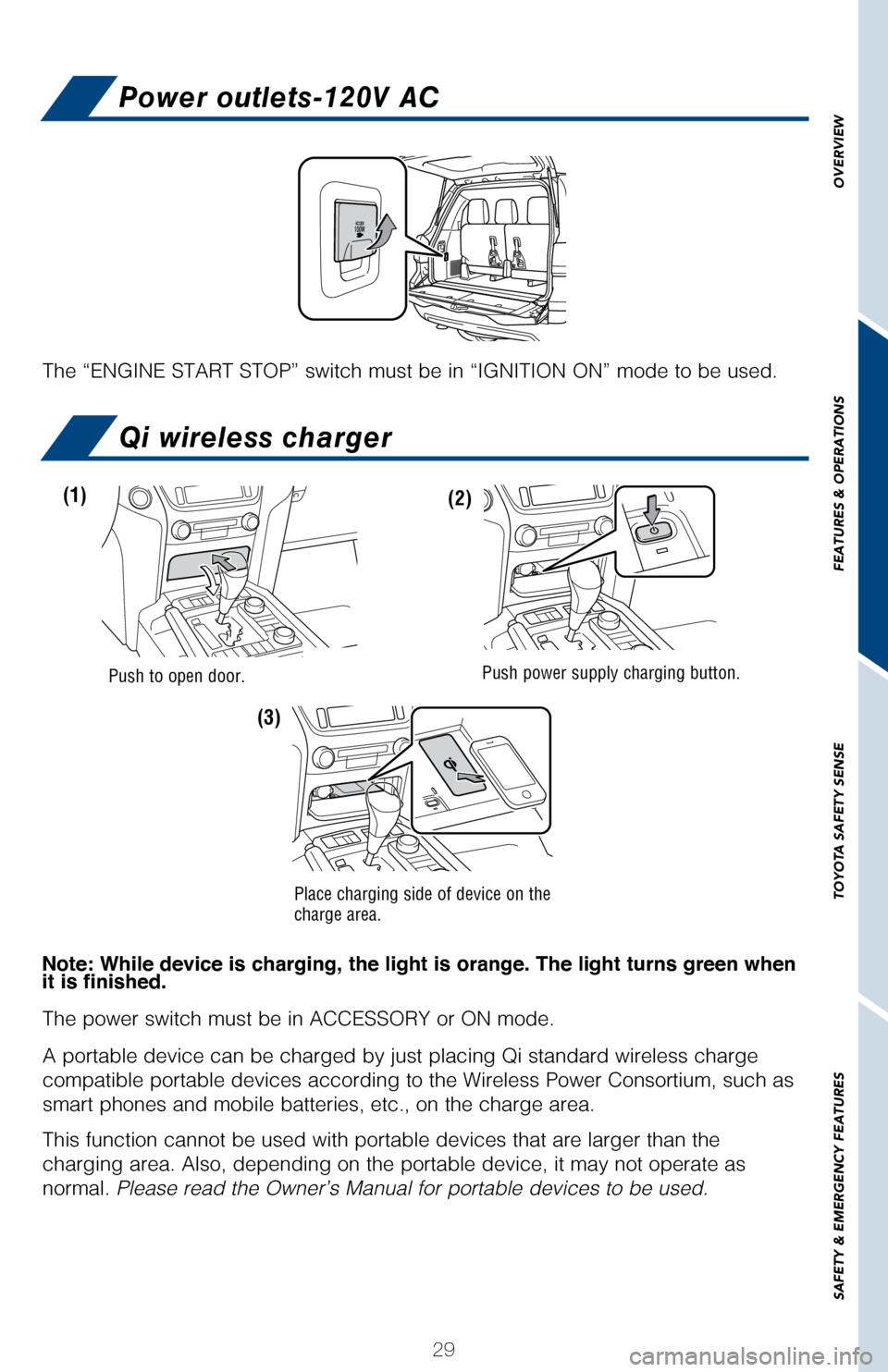
29
OVERVIEW
FEATURES & OPERATIONS
TOYOTA SAFETY SENSE
SAFETY & EMERGENCY FEATURES
Power outlets-120V AC
Qi wireless charger
The “ENGINE START STOP” switch must be in “IGNITION ON” mode\
to be used.
A portable device can be charged by just placing Qi standard wireless ch\
arge
compatible portable devices according to the Wireless Power Consortium, \
such as
smart phones and mobile batteries, etc., on the charge area.
This function cannot be used with portable devices that are larger than \
the
charging area. Also, depending on the portable device, it may not operat\
e as
normal. Please read the Owner’s Manual for portable devices to be used.
The power switch must be in ACCESSORY or ON mode.
(1)
Push to open door.Push power supply charging button.
Note: While device is charging, the light is orange. The light turns green when
it is finished.
Place charging side of device on the
charge area.
(2)
(3)
Page 33 of 54
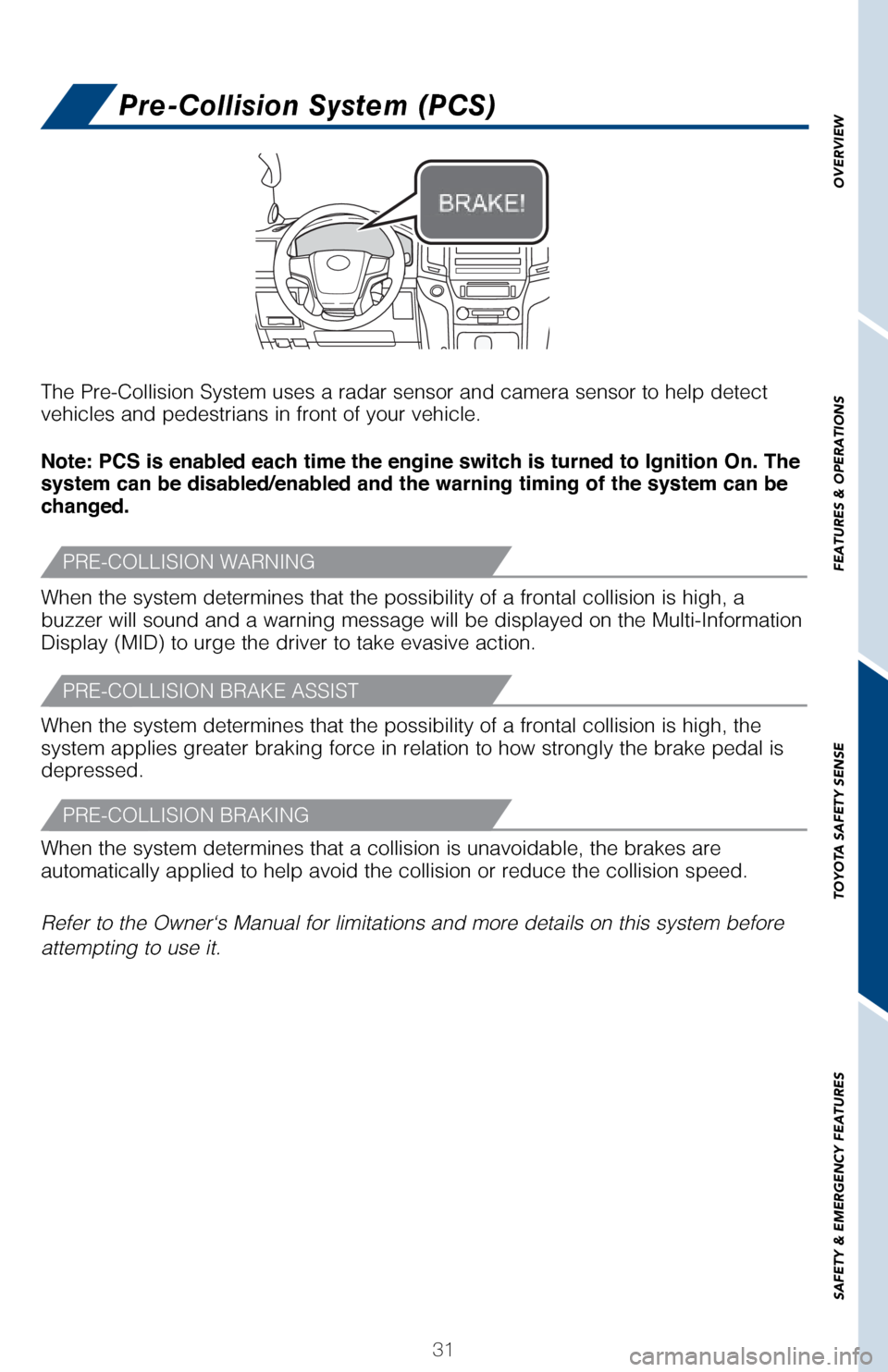
31
OVERVIEW
FEATURES & OPERATIONS
TOYOTA SAFETY SENSE
SAFETY & EMERGENCY FEATURES
PRE-COLLISION WARNING
PRE-COLLISION BRAKE ASSIST
PRE-COLLISION BRAKING
Pre-Collision System (PCS)
The Pre-Collision System uses a radar sensor and camera sensor to help d\
etect
vehicles and pedestrians in front of your vehicle.
Note: PCS is enabled each time the engine switch is turned to Ignition On. The
system can be disabled/enabled and the warning timing of the system can be
changed.
Refer to the Owner‘s Manual for limitations and more details on this \
system before
attempting to use it. When the system determines that the possibility of a frontal collision i\
s high, a
buzzer will sound and a warning message will be displayed on the Multi-I\
nformation
Display (MID) to urge the driver to take evasive action.
When the system determines that the possibility of a frontal collision i\
s high, the
system applies greater braking force in relation to how strongly the bra\
ke pedal is
depressed.
When the system determines that a collision is unavoidable, the brakes a\
re
automatically applied to help avoid the collision or reduce the collisio\
n speed.
Page 34 of 54
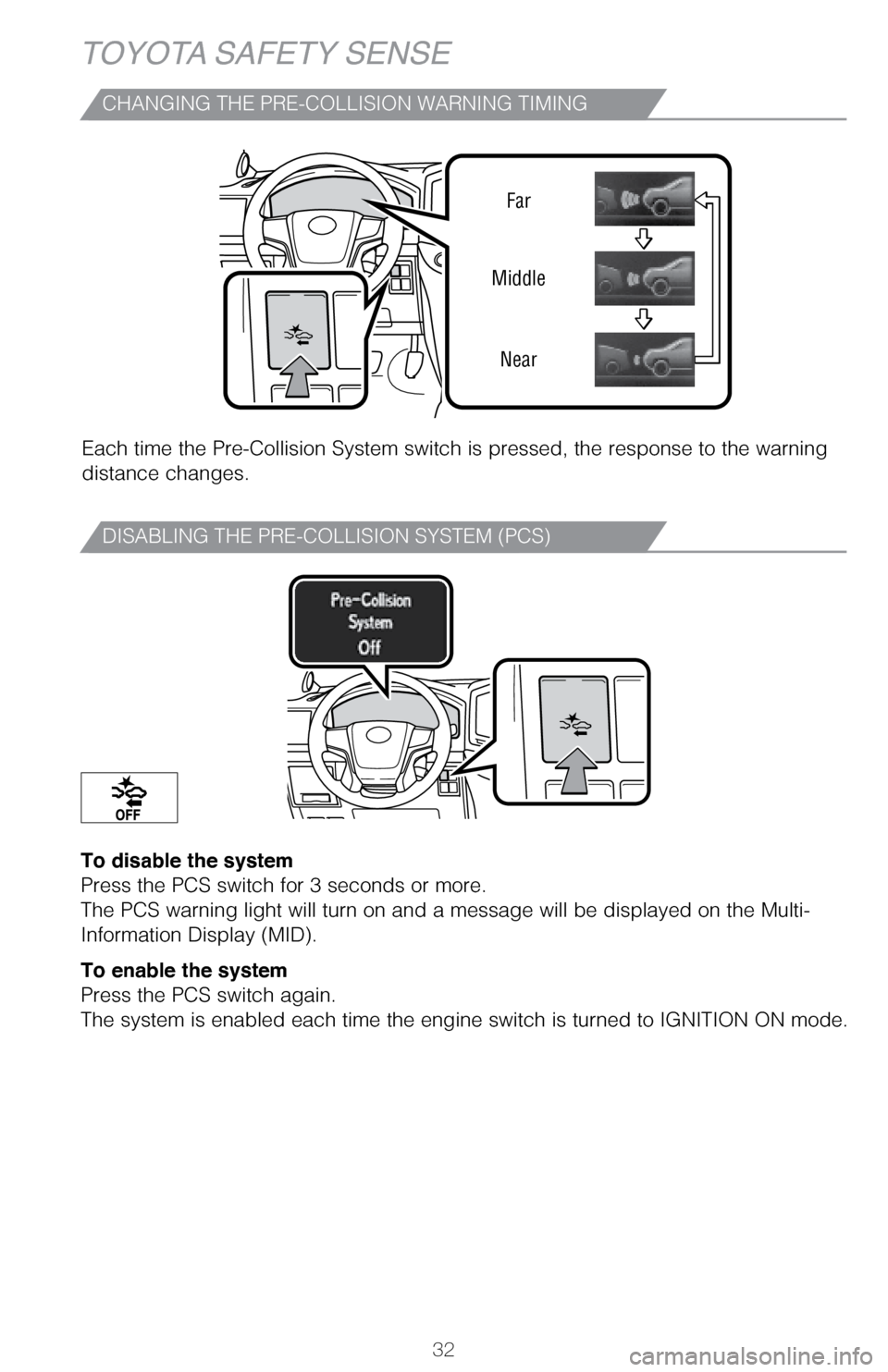
32
TOYOTA SAFETY SENSE
CHANGING THE PRE-COLLISION WARNING TIMING
DISABLING THE PRE-COLLISION SYSTEM (PCS)
Each time the Pre-Collision System switch is pressed, the response to th\
e warning
distance changes.
To disable the system
Press the PCS switch for 3 seconds or more.
The PCS warning light will turn on and a message will be displayed on th\
e Multi-
Information Display (MID).
To enable the system
Press the PCS switch again.
The system is enabled each time the engine switch is turned to IGNITION \
ON mode.
Far
Middle
Near
Page 35 of 54
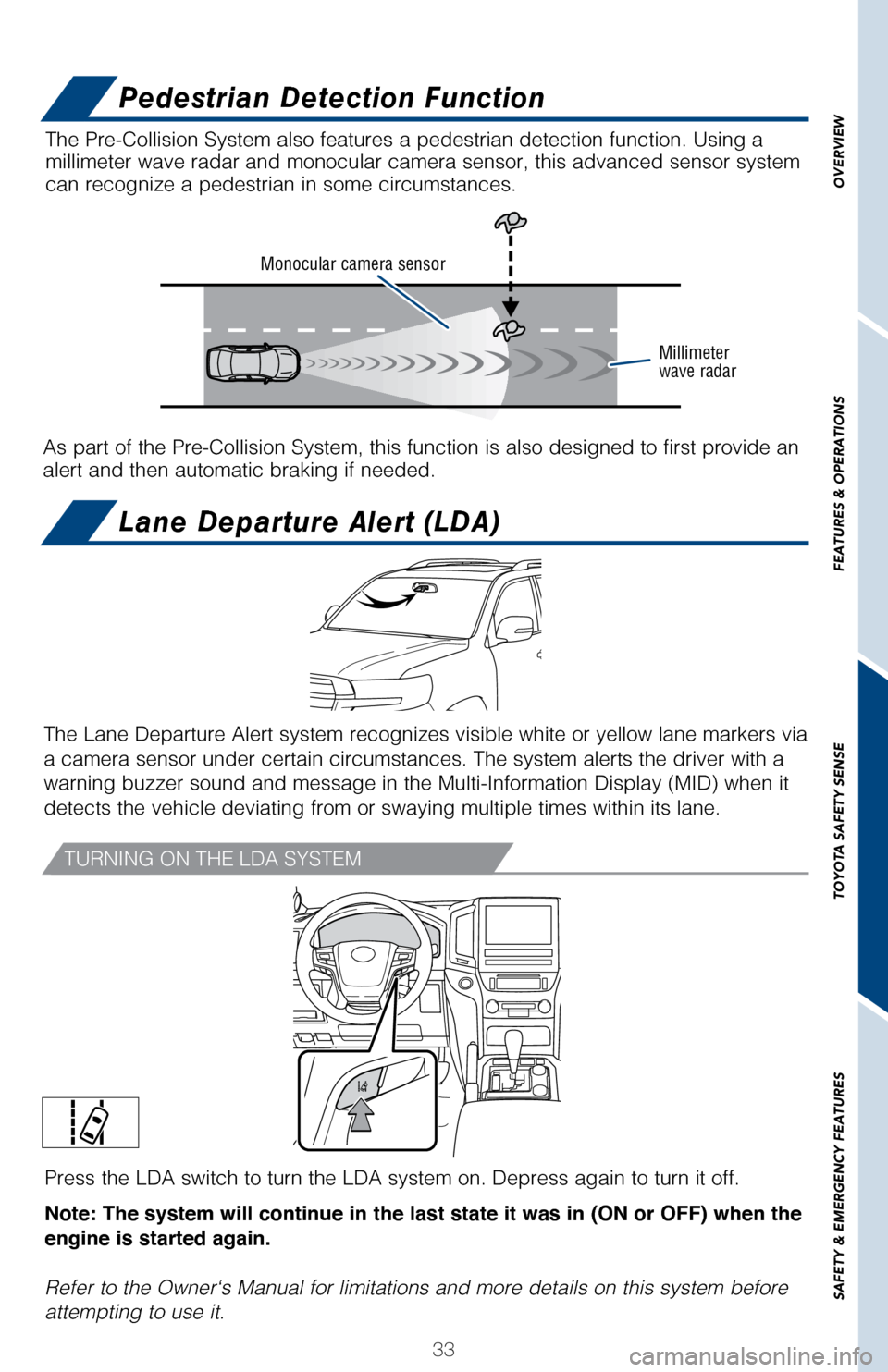
33
OVERVIEW
FEATURES & OPERATIONS
TOYOTA SAFETY SENSE
SAFETY & EMERGENCY FEATURES
Pedestrian Detection Function
Lane Departure Alert (LDA)
TURNING ON THE LDA SYSTEM
Monocular camera sensor
Millimeter
wave radar
As part of the Pre-Collision System, this function is also designed to f\
irst provide an
alert and then automatic braking if needed.The Pre-Collision System also features a pedestrian detection function. \
Using a
millimeter wave radar and monocular camera sensor, this advanced sensor \
system
can recognize a pedestrian in some circumstances.
Press the LDA switch to turn the LDA system on. Depress again to turn it\
off.
Note: The system will continue in the last state it was in (ON or OFF) when the
engine is started again.
Refer to the Owner‘s Manual for limitations and more details on this \
system before
attempting to use it.
The Lane Departure Alert system recognizes visible white or yellow lane \
markers via
a camera sensor under certain circumstances. The system alerts the drive\
r with a
warning buzzer sound and message in the Multi-Information Display (MID)\
when it
detects the vehicle deviating from or swaying multiple times within its \
lane.
Page 40 of 54
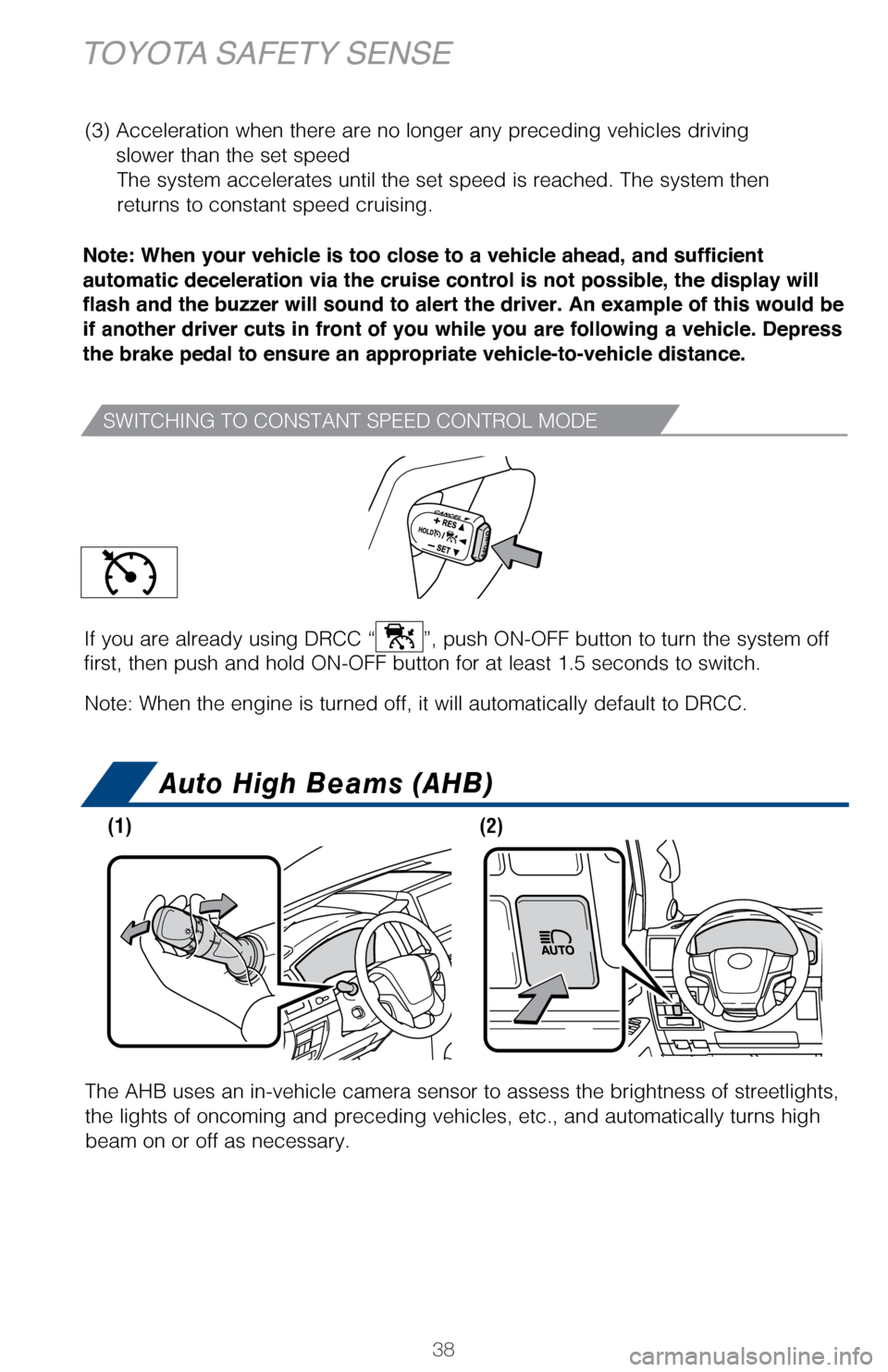
38
Auto High Beams (AHB)
TOYOTA SAFETY SENSE
SWITCHING TO CONSTANT SPEED CONTROL MODE
The AHB uses an in-vehicle camera sensor to assess the brightness of str\
eetlights,
the lights of oncoming and preceding vehicles, etc., and automatically t\
urns high
beam on or off as necessary.
(3) Acceleration when there are no longer any preceding vehicles drivi\
ng
slower than the set speedThe system accelerates until the set speed is reached. The system then
returns to constant speed cruising.
Note: When your vehicle is too close to a vehicle ahead, and sufficient
automatic deceleration via the cruise control is not possible, the display will
flash and the buzzer will sound to alert the driver. An example of this would be
if another driver cuts in front of you while you are following a vehicle. Depress
the brake pedal to ensure an appropriate vehicle-to-vehicle distance.
Note: When the engine is turned off, it will automatically default to DR\
CC.
If you are already using DRCC “
”, push ON-OFF button to turn the system off
first, then push and hold ON-OFF button for at least 1.5 seconds to swit\
ch.
(1) (2)
Page 41 of 54

39
OVERVIEW
FEATURES & OPERATIONS
TOYOTA SAFETY SENSE
SAFETY & EMERGENCY FEATURES
ACTIVATING THE AHB SYSTEM
CONDITIONS WHERE AHB WILL TURN ON/OFF AUTOMATICALLY
When all of these conditions are met, high beams will be automatically t\
urned on
(after approximately 1 second):
• Vehicle speed is above approximately 25 mph (40 km/h).
• The area ahead of the vehicle is dark.
• There are no oncoming or preceding vehicles with headlights or tail\
lights
turned on.
If any of these conditions occur, the system is designed to automaticall\
y turn off
highbeams. • Vehicle speed drops below approximately 19 mph (30 km/h).
• The area ahead of the vehicle is not dark.
• Oncoming or preceding vehicles have headlights or tail lights
turned on.
• There are many streetlights on the road ahead.
(1) With the engine switch in IGNITION ON mode and headlight switch tu\
rned to
“AUTO” position, push lever away from you.
(2) Depress the Automatic High Beam “AUTO” switch. The AHB indicator will come on when the headlights are turned on automat\
ically
to indicate that the system is active.
Note: Pull the lever back toward you to turn the AHB system off.
The AHB indicator will turn off and the high beam indicator turns on.
Page 42 of 54
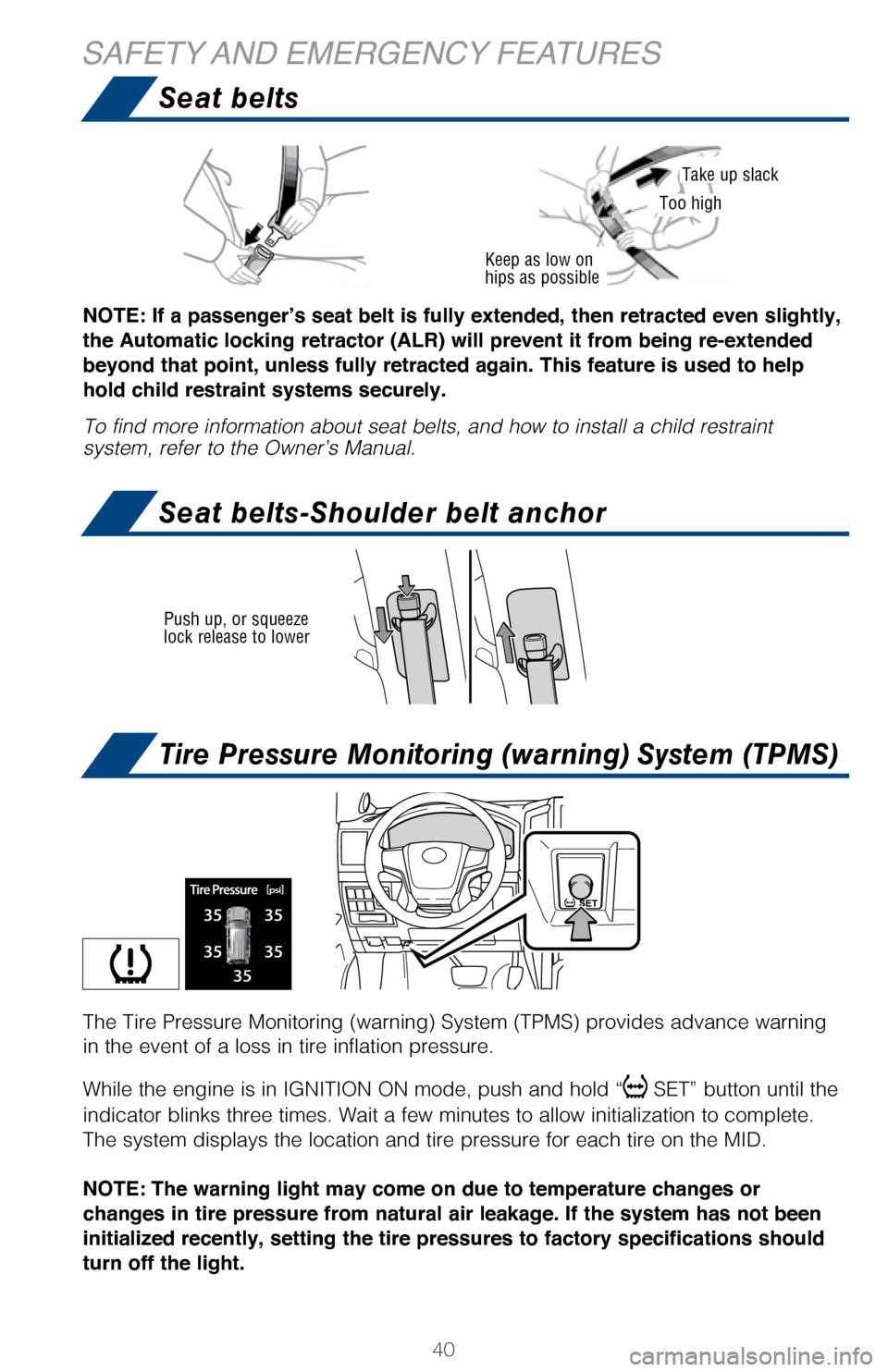
40
NOTE: If a passenger’s seat belt is fully extended, then retracted even slightly,
the Automatic locking retractor (ALR) will prevent it from being re-extended
beyond that point, unless fully retracted again. This feature is used to help
hold child restraint systems securely.
To find more information about seat belts, and how to install a child re\
straint
system, refer to the Owner’s Manual.
Keep as low on
hips as possible
Take up slack
Too high
Push up, or squeeze
lock release to lower
The Tire Pressure Monitoring (warning) System (TPMS) provides advanc\
e warning
in the event of a loss in tire inflation pressure.
While the engine is in IGNITION ON mode, push and hold “
SET” button until the
indicator blinks three times. Wait a few minutes to allow initialization\
to complete.
The system displays the location and tire pressure for each tire on the \
MID.
NOTE: The warning light may come on due to temperature changes or
changes in tire pressure from natural air leakage. If the system has not been
initialized recently, setting the tire pressures to factory specifications should
turn off the light.
Seat belts
Seat belts-Shoulder belt anchor
Tire Pressure Monitoring (warning) System (TPMS)
SAFETY AND EMERGENCY FEATURES
Page 44 of 54
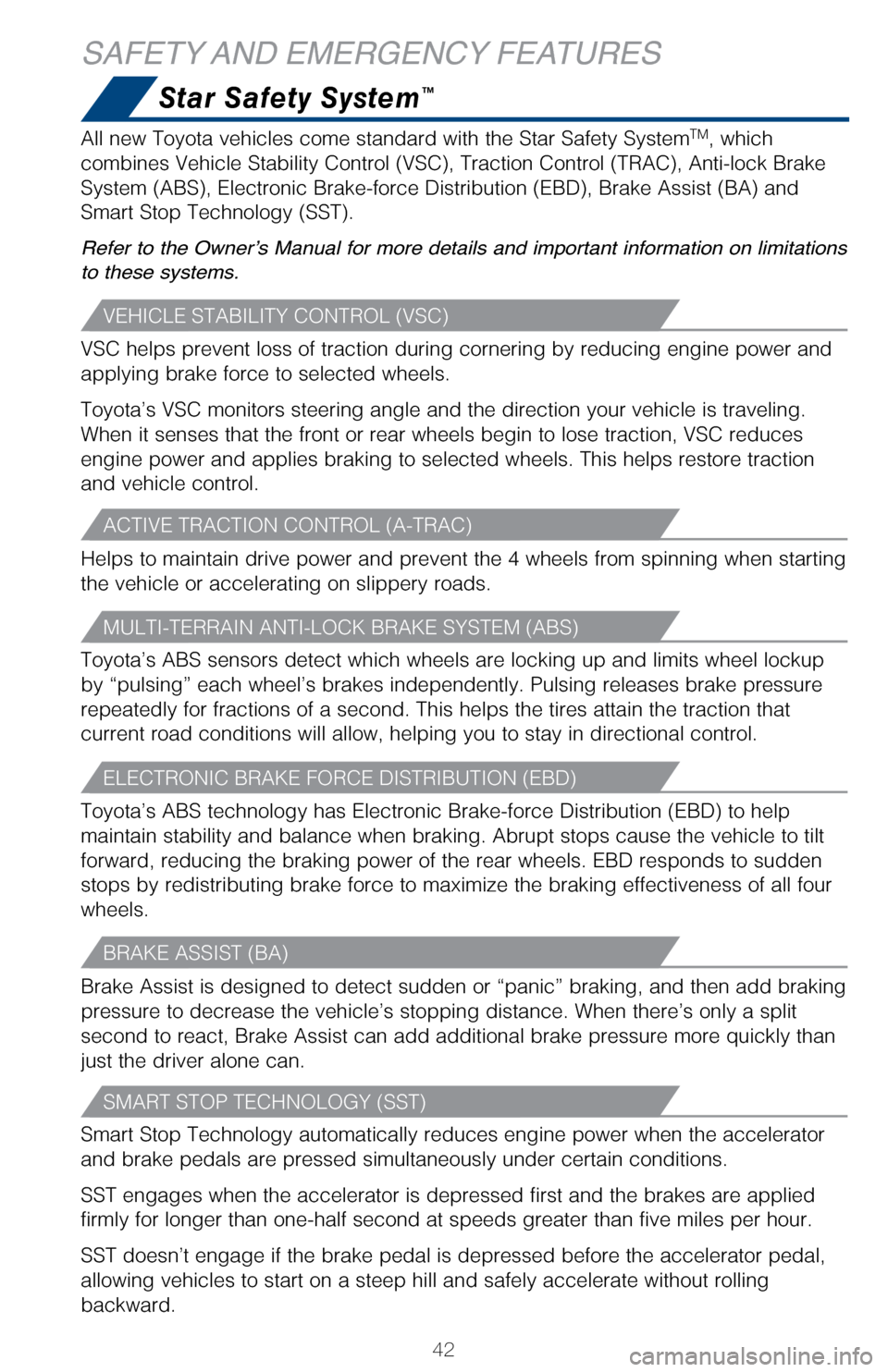
42
Star Safety System™
SAFETY AND EMERGENCY FEATURES
Smart Stop Technology automatically reduces engine power when the accele\
rator
and brake pedals are pressed simultaneously under certain conditions.
SST engages when the accelerator is depressed first and the brakes are a\
pplied
firmly for longer than one-half second at speeds greater than five miles\
per hour.
SST doesn’t engage if the brake pedal is depressed before the acceler\
ator pedal,
allowing vehicles to start on a steep hill and safely accelerate without\
rolling
backward. VSC helps prevent loss of traction during cornering by reducing engine p\
ower and
applying brake force to selected wheels.
Toyota’s VSC monitors steering angle and the direction your vehicle i\
s traveling.
When it senses that the front or rear wheels begin to lose traction, VSC\
reduces
engine power and applies braking to selected wheels. This helps restore \
traction
and vehicle control.
Toyota’s ABS sensors detect which wheels are locking up and limits wh\
eel lockup
by “pulsing” each wheel’s brakes independently. Pulsing release\
s brake pressure
repeatedly for fractions of a second. This helps the tires attain the tr\
action that
current road conditions will allow, helping you to stay in directional c\
ontrol.
Brake Assist is designed to detect sudden or “panic” braking, and \
then add braking
pressure to decrease the vehicle’s stopping distance. When there’s\
only a split
second to react, Brake Assist can add additional brake pressure more qui\
ckly than
just the driver alone can. Helps to maintain drive power and prevent the 4 wheels from spinning whe\
n starting
the vehicle or accelerating on slippery roads.
Toyota’s ABS technology has Electronic Brake-force Distribution (EBD\
) to help
maintain stability and balance when braking. Abrupt stops cause the vehi\
cle to tilt
forward, reducing the braking power of the rear wheels. EBD responds to \
sudden
stops by redistributing brake force to maximize the braking effectivenes\
s of all four
wheels. All new Toyota vehicles come standard with the Star Safety System
TM, which
combines Vehicle Stability Control (VSC), Traction Control (TRAC), A\
nti-lock Brake
System (ABS), Electronic Brake-force Distribution (EBD), Brake Assis\
t (BA) and
Smart Stop Technology (SST).
Refer to the Owner’s Manual for more details and important information on limitations
to these systems.
VEHICLE STABILITY CONTROL (VSC)
ACTIVE TRACTION CONTROL (A-TRAC)
MULTI-TERRAIN ANTI-LOCK BRAKE SYSTEM (ABS)
ELECTRONIC BRAKE FORCE DISTRIBUTION (EBD)
BRAKE ASSIST (BA)
SMART STOP TECHNOLOGY (SST)